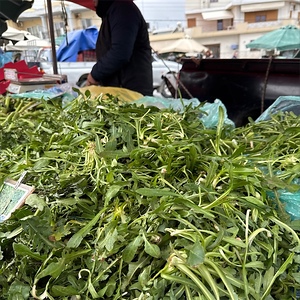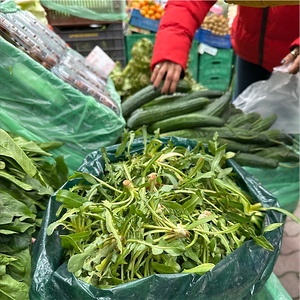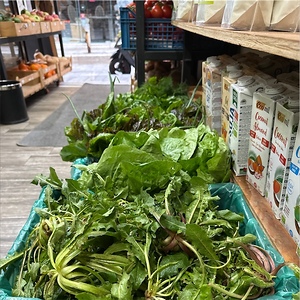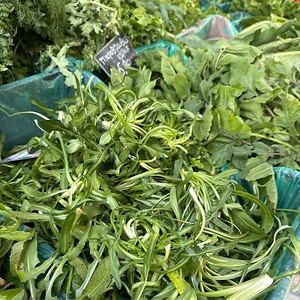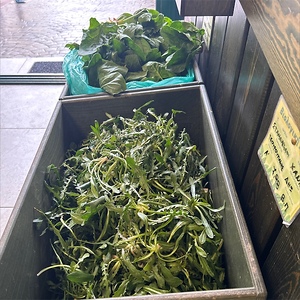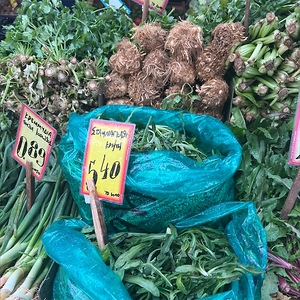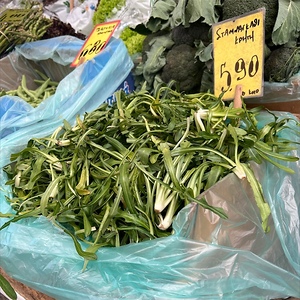


Stamnagathi
Estimated Inventory, lb : 0
Description/Taste
Stamnagathi is harvested when it is small in size and appears in low-growing rosettes. The slender, long leaves average 8 to 10 centimeters in length and form from a singular base, creating a small cluster. Each leaf has a flat, narrow, and pliable nature with serrated edges and a bluntly curved tip. It is important to note that wild and cultivated leaves may vary in appearance, with cultivated versions being less serrated and lighter in color. Stamnagathi has a dark green coloring with prominent central ribs traveling the length of the leaf. The greens are collected when they are young, tender, and crisp. If left to mature, the leaves become prickly, fibrous, and unpalatable. Stamnagathi emits a fresh, earthy aroma, and the leaves are edible raw or cooked. Raw Stamnagathi has a grassy, spicy, and bitter, sometimes sweet taste. The greens are often served with olive oil and lemon to help balance their strong flavor. Cooked Stamnagathi leaves are still bittersweet but milder in overall flavor with green, vegetal nuances.
Seasons/Availability
Cultivated Stamnagathi is available year-round. Wild Stamnagathi is available from late winter through spring.
Current Facts
Stamnagathi, botanically classified as Cichorium spinosum, is a Mediterranean species belonging to the Asteraceae family. Wild forms of Stamnagathi have been naturally growing since ancient times and are hardy plants, forming mound-like clusters of leaves and thorns reaching twenty centimeters in height. Stamnagathi is a Greek name for young rosettes of tender leaves foraged for culinary and medicinal purposes. The species is known by several other regional names throughout Greece, including Radicchio Tsi Thalassas, Gialoradiko, Brachophana, Alifoni, Alochorto, and Tzibeloradiko. It is also known as Spiny Chicory in English. Each year, new leaves appear after the first rain in the early winter and are harvested approximately 3 to 4 months after sprouting. Stamnagathi has historically been foraged by hand from wild plants. The small rosettes are sliced with a knife at the base to ensure the roots remain intact to sprout new leaves in the next growing cycle. Once harvested, the greens are sold in local markets and are utilized by restaurants and home kitchens in raw and cooked preparations. The story of Stamnagathi is deeply intertwined with the cultural practices of the island of Crete. The species grows wild across the island and is believed to have a distinct flavor due to the island’s unique microclimates and soils. Stamnagathi was also successfully cultivated in the early 21st century to meet increasing demand, as greens are rising in popularity throughout Greece due to their nutritional properties.
Nutritional Value
Stamnagathi is known for its antioxidant, antirheumatic, and antiseptic properties. The species has been recorded in writings among ancient Greek physicians for its diuretic and live-detoxing capabilities and is believed to help cleanse the kidneys, liver, and gallbladder. It is said Stamnagathi contains glutathione, a substance made from several amino acids in the liver that help neutralize free radicals and detox the body. In Crete, when Stamnagathi leaves are boiled for culinary preparations, the boiled water is saved and drunk as a medicinal tea. Olive oil and lemon juice are often mixed into this water for a more palatable flavor as a cleansing drink. Stamnagathi also provides vitamins A, C, and E and omega-3 fatty acids to strengthen the immune system and maintain the body's overall health. Beyond vitamins, Stamnagathi contains fiber to regulate the digestive tract, potassium to balance fluid levels within the body, and magnesium to control nerve functions. The greens also have other nutrients, including iron, calcium, zinc, and linoleic acid, which is believed to help clean clogged arteries.
Applications
Stamnagathi has an earthy, bittersweet, green, and grassy flavor suited for fresh and cooked preparations. The greens must be washed before use and can be added raw to salads. Stamnagathi is often served with arugula, avocado, garlic, or tomatoes to help balance its pungent flavor. Raw greens are also tossed with olive oil, salt, vinegar, or lemon juice and served as a fresh side dish. In addition to raw preparations, Stamnagathi is typically blanched, boiled, sauteed, or steamed. The cooked greens can be incorporated into omelets, pasta, and risotto or simmered into soups and stews. Stamnagathi is also served as a side dish with meatballs, cooked with oyster mushrooms, or mixed with broad beans and grilled onions as a vegetarian dish. In Crete, Greece, Stamnagathi is traditionally cooked into fricassee, a meat dish stewed in an avgolemono or a lemon-based sauce. It is customary to serve the greens with lamb, pork, goat, or rabbit, with lamb being the most popular. Stamnagathi is also topped over rusks with chopped tomatoes, onions, and cheeses, or fried eggs. One of the most famous uses for Stamnagathi is to incorporate the greens into pastry pies, called hortopita or kalitsounia. These flaky pastries are cooked in pans and are comprised of a mix of wild and cultivated greens, sometimes combined with other herbs and cheeses. Green pies were once made as portable meals for farmers and shepherds, but over time, they became a favorite item to serve family and friends as a symbol of hospitality. For extended use, Stamnagathi is preserved in brine or dehydrated and ground into a powder. Stamnagathi pairs well with extra virgin olive oil and aromatics such as garlic, onions, olives, artichokes, leeks, dill, and lemons. Unwashed, raw Stamnagathi should be immediately used after purchase for the best quality and flavor. The greens have a short shelf life and will only keep for 2 to 3 days when wrapped in a paper towel to absorb moisture and placed in the lower parts of the refrigerator.
Ethnic/Cultural Info
The name Stamnagathi is derived from traditional practices of using the species as a cover over water containers in ancient Greece. “Stamna” was a name for a clay vessel that was once used to hold water. These vessels were carried to streams and other natural water sources, especially in Crete, and were filled to transport water back to homes in the villages. During collection, it was common to encounter insects in the water. Cretan communities eventually used the Stamnagathi plant to cover the tops of the clay vessels as a natural filter to prevent bugs from floating into the containers. Mature Stamnagathi plants are a mixture of leaves, branching stems, and thorns, and these thorns act as a barrier and lid, allowing communities to collect clean water. The second part of the word, “agathi,” is a Greek word meaning “thorn,” giving the plant its name that is still used today.
Geography/History
Stamnagathi is native to the Mediterranean and has been growing wild since ancient times. The species is primarily found in Greece, Italy, Turkey, Cyprus, Malta, and Spain, and thrives in a variety of soils from sandy, acidic, neutral, and rocky. Stamnagathi is found in mountainous and shoreline regions, and the plants are low-growing and often present in hard-to-reach locations. The species has been recorded in documents from ancient physicians and naturalists, including Dioscorides, Aristophanes, and Theophrastus, and has been historically used as a medicinal and culinary ingredient. Despite its presence throughout the Mediterranean, Stamnagathi is prevalent in Greece and still grows wild in Crete. The species is notable on the Omalos Plateau in the White Mountains of Western Crete and is grown on other parts of the island. Areas of Central Greece, the Cyclades, and the Peloponnese also harvest wild plants. In 2009, a company known as Cretan Gaia established the first commercial cultivation of Stamnagathi in the town of Moires, Crete, allowing the plants to be grown hydroponically. Cultivation has expanded Stamnagathi’s availability year-round, but locals prefer wild foraged greens due to their stronger flavor and nutritional properties. Today, Stamnagathi is grown in the mountains and along the Mediterranean Sea. When wild plants are in season, the fresh rosettes are sold in large piles through local markets and select grocery stores.
Recipe Ideas
Recipes that include Stamnagathi. One
| Greek Recipe |
|
Stamnagathi Salad |
| Vegan in Athens |
|
Stamnagathi ,Cherry Tomatoes, Traditional Cretan Barley Rusk and Vinegret Salad |



